Transplanting roses to another place in the fall
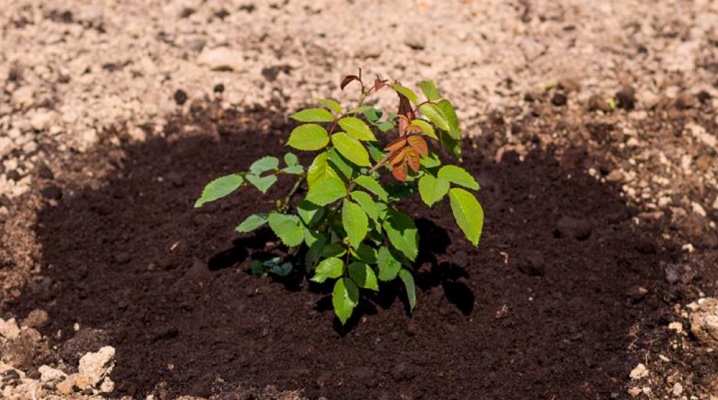
Any area decorated with flowers looks beautiful and pleasing to the eye. Roses are one of the most attractive crops, because many people try to plant them near their home or entrance. In order for the flowers to grow well and please with a full and exuberant flowering, it is necessary to find the right place for them and transplant in compliance with all the technologies of this procedure.
Autumn transplantation is the most favorable, therefore it is important to know all the features of transferring bushes from one place to another, the timing of this event and the specifics of subsequent care.


Peculiarities
The rose is a beautiful flower with a pleasant aroma, which is loved by adults and children, men and women. Roses are given for birthdays, weddings, and other celebrations; they are planted in parks, near residential complexes and in the private sector. Such popularity of these flowers makes you want to grow them, which means you need to be able to cultivate this plant. Rose, like any other flower, has its own characteristics of development, preferences and nuances of care. To grow a rose, you need to have a certain knowledge base, without which even the most unpretentious variety will begin to fade.
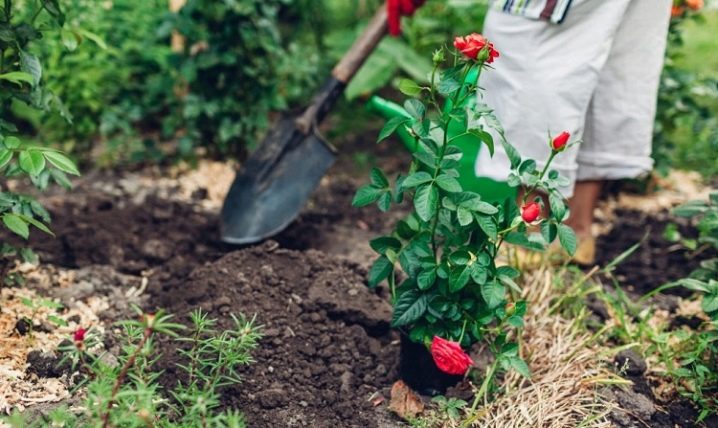
In addition to the usual planting of a new plant, you may need to transplant roses to another place. There may be several reasons for this.
- The need to re-plan the site for new trees, the construction of a farm building or the transfer of a flower garden to another place.
- Transferring one or more bushes to an already created composition. If there is an already formed rose garden and some of the bushes are dying in it, then the flower bed looks poor and sloppy. To rectify the situation, it is enough to plant new bushes in the place of the victims.
- Unsuitable growing conditions for roses... The area chosen for a flower garden may be in the shade, the soil may be heavy, underwater currents can cause rotting of the root system, plants nearby can negatively affect the bushes, oppressing them.
- Unsuitable soil type... Roses need optimal soil for the bushes to grow normally and bloom well. If the soil is clay, then the roots often come to the surface of the soil, which is why they dry out. In very loose soil, the root system deepens and depletes the soil, leaving no nutrients for the crop to grow.
- Growth of mature bushes. To keep the flower garden neat and well-groomed, it is important to keep track of the size of the roses. If the bushes have grown a lot, then they are cut off and planted.
You can transplant roses every 3-5 years, so that the flower garden pleases with abundant flowering, and the soil is full of useful components. The transplant procedure can be carried out both in autumn and spring. Planting in autumn is more conducive to growing healthy and strong shrubs. Due to the fact that the seedling goes through the winter cold in a new place, it acclimatizes faster and begins to grow more actively in the spring.
If the region is very cold or the weather is too unstable, then planting such a crop is best done in the spring. For the bush to take root in a new place, it takes 2 to 3 weeks. In temperate climates, where cold weather occurs in October and November, it is better to replant roses in the fall, and where it gets colder early, and there may be unforeseen frosts, it is optimal to carry out work in the spring.

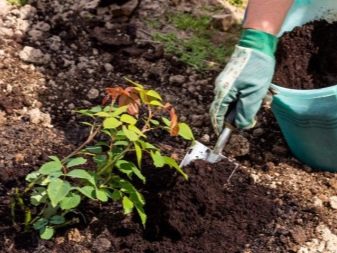
Timing
In order to choose the right time when it is better to transplant roses, you must first take into account the peculiarities of the region. In the southern regions, it is worth carrying out the procedure in October or November. The warmer the region, the more you can delay with work. Later on November 15-20, it is no longer worth starting a transplant, since the weather can change dramatically, the bushes will not have time to take root in a new place and will die. In the central regions, it is best to plant roses in September or October. When it is still warm outside, but the sun is no longer beating down and there is a reserve before the frost begins, this is the most favorable moment for gardening. In the northern regions and in places where it gets colder very early and strongly, it is recommended to replant the bushes in the spring, since the frost can hit already in September.
To choose a suitable month for work, it is worth looking at the long-term weather forecast. If frosts are promised only in winter, then you can safely work in October and November, if the first cold weather is expected by the end of autumn, then the optimal time will be September or early October. In regions where it is cold already in mid-October, you can transplant roses in late August or early September.
Work is allowed in August if the first frosts are already at the end of September.

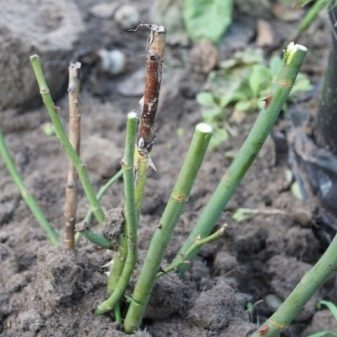
When choosing between autumn and spring planting of roses, you should focus on the pros and cons of each option. The advantages of autumn work include:
- active growth of the bush in spring;
- the presence of a sufficient amount of moisture in the soil allows the roots to fully develop and provide themselves with comfortable conditions for wintering;
- temperature fluctuations are more stable in autumn than in spring;
- the presence of a huge number of seedlings that can be selected and transplanted;
- while the bush is actively growing, you can fully evaluate it and choose the healthiest and strongest, in the spring it is harder.
In addition to the positive aspects, there are a number of disadvantages, which include:
- the beginning of the development of the bush after planting, which is not always good if a cold snap is expected soon;
- untimely planting in the fall can cause the bushes to freeze;
- improper measures for covering roses for the winter can provoke the development of fungal diseases, and in the spring the bush will be affected by them.
When planting in spring, it will be necessary to pluck all the buds, preventing the flowering of the bushes in the first time after work, so that the culture spends its energy on rooting and growing in a new place.
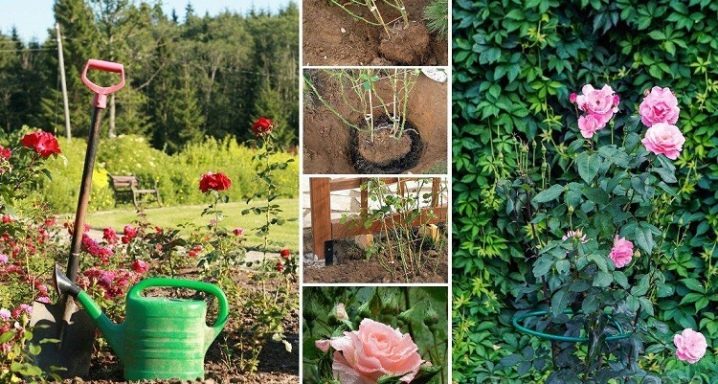
Preparation
In order to properly transplant a rose bush to a new place, it is necessary to start caring for it from August. An important event will be the introduction of fertilizing and fertilization, which will activate the growth of roots and make the plant stronger and more resilient. Superphosphate, potassium salt, potassium chloride can be added under the bush. The next stage of preparation is crop pruning. In autumn, when night temperatures begin to drop to 0 °, it is necessary to cut off all the leaves and significantly shorten the shoots. To enhance root growth, the tips also need to be trimmed.
Before replanting rose bushes, you need to choose a suitable place for them and prepare the soil. Roses love the sun, however, direct rays can provoke damage to the foliage, therefore it is important to choose an area where there will be an alternation of light and shadow. The area for the flower garden should not be in a draft, it is harmful to plants. The soil should be light, loamy, without groundwater that will flood the site.
The hole for the plant should not be very large, its dimensions will be slightly larger than the earthen lump in which the new bush will be transferred - the depth is about 70 cm, and the width is about 40 cm. If the planting is carried out in the place where the rose died, then it is better to completely replace the soil on this piece of land. A couple of days before transplanting, fertilizers are poured into the prepared hole, and after the procedure, the bush is covered with a small amount of earth to hide the roots and prevent the sun's rays from reaching them.

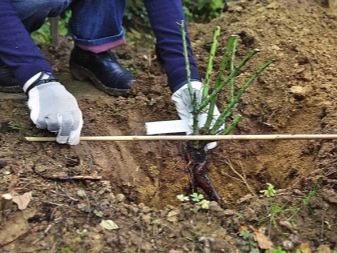
There is a wide variety of roses, and each variety has its own characteristics of transplantation.For spray roses, the process of planting in a new place consists in preparing a bush and a hole, after which the seedling is transferred to a new site. For a climbing rose, the order of work is about the same, the bush is watered abundantly, cut off, shoots 25-30 cm long are left, an earthen ball is dug out, with which the plant is transferred to a new place, planted and covered with spruce branches for wintering.
Despite the different varieties, there may be several reasons for transplanting roses to a new place:
- depletion of the soil;
- too big bush;
- not the right place.
Roses do not grow in one place for a long time, since the roots actively absorb nutrients from the soil, therefore every 3-5 years you need to change the place of the flower garden on the site. An adult rose needs to be rejuvenated and planted. To divide the bush, you should carefully cut the plant so that each seedling has a sufficient number of roots and twigs.
If the region is very cold and the flowers do not survive after winter, they can be transplanted from the garden to the pot for the winter, and returned to their place in the spring. Correct work on the site will allow you to quickly transfer the bushes to a new place and provide them with all the necessary conditions for normal growth and development.

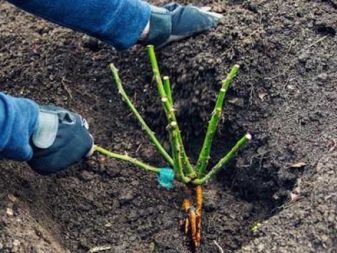
With a clod of earth
There are two options for transplanting roses, one involves transferring a plant with a lump of earth in which it grows, the other - the absence of any old soil. The need to use land from the old site arises when the bush is weakened or there is not much time for rooting.
To transplant a rose with a clod of earth, you need to do the following.
- Water the flower with plenty of water a couple of hours before work.
- Tie up the shoots with a rope so that they are nearby, do not fall and do not interfere with work.
- Dig in the trunk of the bush in a circle, leaving a distance of 20-25 cm from the rose.
- Deepen the ditch, moving down to the base of the flower. If very long roots are encountered, they must be chopped off.
- When the bush is completely dug up, it is necessary to lift it with a shovel with one hand, and hold the trunk with the other, and thus transfer it to a new place. You need to work without haste - so that the earth does not collapse from the roots.
- The bush is set in a new hole at the same depth as it grew in the old place.
- Empty areas in the new pit are filled with prepared soil and compacted by hand.
Once the transplant is complete, the plant is watered with 20 liters of warm water. After such work, the bush will quickly take root in a new place and will more easily survive frosts.
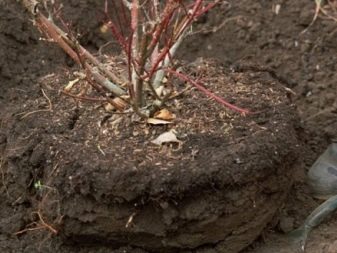
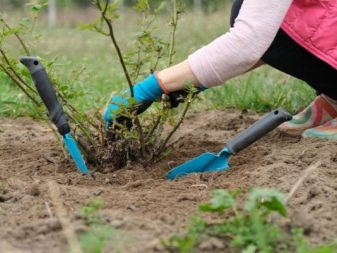
Without soil
If the rose bushes are strong, have a good root system, then they can be transplanted without an earthen coma. To carry out this activity, you must follow the sequence of steps.
- It is good to water the bush before starting work to ensure faster extraction of the plant from the soil.
- On the bush that was dug, it is necessary to examine the entire underground part. Roots and shoots should be checked for diseases and pests. If there are problematic parts, they must be completely cut off with a secateurs and the cut must be treated with a solution of potassium permanganate.
- The plant is soaked for a day in a solution of "Kornevin" or the like.
- Before planting, the rose must be dipped in a solution of clay and mullein in a 2: 1 ratio.
- Place the seedling in a new hole, spreading the roots to the sides, pointing them down.
- Fill empty pit areas with earth and tamp by hand.
After planting, the bush is watered with 20 liters of water and immediately spudded for the winter.
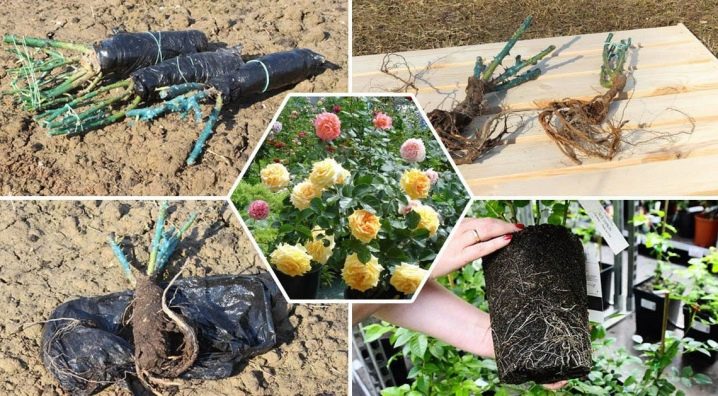
Follow-up care
To help the roses take root in a new place and prepare them for winter, it is necessary to create optimal conditions for them. Caring for plants after transplanting comes down to such activities.
- Watering... After planting, it is necessary to provide the bush with stable watering. It is important to apply moisture regularly, but in small amounts, so that the soil is deeply moistened before the cold weather.If you pour in a lot of water, there is a great risk that the roots will rot and the plant will die.
- Providing shading. After transplantation, direct sunlight will be harmful to the culture, therefore it is important to provide shade for the rose garden.
- Top dressing. In the process of planting a rose, it is necessary to add phosphorus-potassium fertilizers directly to the new hole, providing the bush with the presence of nutrients for the first time. If fertilizers have not been applied, they can be poured onto the soil near the bush after planting and gradually deepened into the soil, digging. In autumn, nitrogen should not be added, as it helps to activate the growth of the green mass of the bush, and before winter this process will be undesirable.
It is necessary to prepare the culture for frost when it gets colder outside to -5 ° C. The bushes are covered with spruce branches or non-woven cloth. If the region is southern, then it is enough just to mulch the soil, covering the bush with a 15-centimeter layer of earth. If all the activities are carried out correctly, then the bush will quickly take root in a new place and from spring it will delight with abundant green mass, and then flowering.


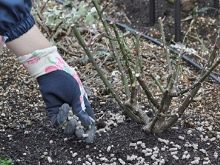

































































































The comment was sent successfully.